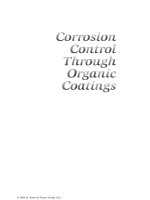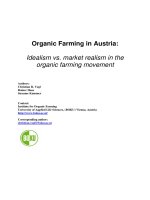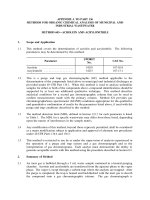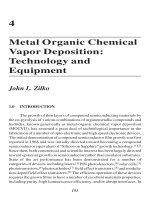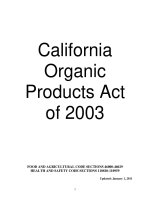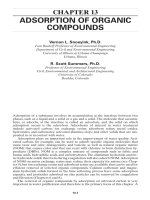ORGANIC SYNTHESES doc
Bạn đang xem bản rút gọn của tài liệu. Xem và tải ngay bản đầy đủ của tài liệu tại đây (325.23 KB, 116 trang )
ORGANIC SYNTHESES
AN ANNUAL PUBLICATION OF SATISFACTORY METHODS FOR THE
PREPARATION
OF ORGANIC CHEMICALS
_EDITORIAL BOARD_
JAMES BRYANT CONANT, _Editor-in-Chief_ HANS THACHER CLARKE
ROGER
ADAMS OLIVER KAMM
_CONTRIBUTORS_ G. H. COLEMAN J, C. HESSLER E. P. KOHLER C. S.
MARVEL
W. A. NOYES G. R. ROBERTSON E. B. VLIET F. C. WHITMORE
VOL. II.
Caveat: Some numbers did not OCR correctly and may not have been
corrected during the proofing! Check the 1941 print edition
before trying these!
INTRODUCTION TO THE SERIES
THE publication of this series of pamphlets has been undertaken
to make available in a permanent form complete detailed directions
for the preparation of various organic chemical reagents.
In announcing this purpose it may be well to mention at the outset
some of the difficulties in the way of the research chemist, which it
is hoped this series will be able to overcome. The cost of chemicals
is prohibitive to the majority of chemists; this was true before
the war when Kahlbaum's complete supply was available, and to-day
with our dependence on domestic stocks, this cost has increased.
The delay in obtaining chemicals, especially from abroad,
even if the expense need not be considered, is an important factor.
These difficulties have therefore thrown the research chemist on his
own resources. The preparation of materials for research, always time
consuming and annoying, is made increasingly so by the inexactness
of the published information which so often omits essential details.
Because of this, much needless experimentation is necessary
in order to obtain the results given in the published reports.
As the additional information thus acquired is seldom published,
duplication of such experiments occurs again and again,
a waste of time and material. It is hoped these difficulties
may be remedied by the publication of this series of pamphlets.
In other words, the authors hope to make this a clearing house
for the exchange of information as to methods of preparation of some
of the most needed organic chemical reagents.
On account of the impossibility of obtaining the less common
organic chemicals in the United States during the past few years,
university laboratories have had no option but to prepare their
own supplies. At the University of Illinois, for instance,
a special study has been made of this field, and methods for
the production of various substances have been investigated.
As a result, reliable methods and directions have been developed
for producing the materials in one-half to five pound lots.
Such work as Illinois has done is now being given an even more extensive
scope at the Research Laboratory of the Eastman Kodak Company. It is
felt that the results from these various laboratories should be
available to all chemists and it is hoped that they eventually
will be completely incorporated in these pamphlets.
The organic chemicals herein discussed have been quite
arbitrarily chosen, being those which have been needed in various
research laboratories in the last years and for which the directions
happen now to be ready for publication. The methods are in only
a few cases new ones; they are in general the most satisfactory
to be found in the literature. Only such details have been added
as will enable a man with a reasonable amount of experience
in organic chemistry to duplicate the results without difficulty.
To be absolutely sure that each set of directions can be repeated,
every experiment has been carried out in at least two laboratories.
Only after exact duplication of the results in both laboratories
are the directions considered ready for publication.
The names of the chemists who have studied the various experiments
are given so that further information concerning any obscure point
can be obtained if any question arises in using these directions.
And finally, in describing the experiments, special attention has
been given to the explanation of why it is necessary to follow
the directions carefully, and what will happen if these directions
are not followed.
Although the main object in this series is to give the most convenient
laboratory methods for preparing various substances in one-half
to five pound lots, an attempt has also been made to have these
processes as far as possible adaptable to large scale development.
For example, extractions have been avoided wherever possible,
cheap solvents have been sub-stituted for expensive ones,
and mechanical agitation, a procedure extremely important in the
success of many commercial processes, has usually been specified.
The apparatus used is always carefully described and wherever necessary
an illustration is given. Accompanying each preparation there will
be found a bibliography containing references to all the methods
for the production of the substance described in the literature.
This is given in order to aid any future investigator who
may wish to study or improve the methods of preparation.
It is not claimed that the methods are, in every case,
completely perfect, but only that the yields are very satisfactory
and allow the production of the substances at a reasonable cost.
It is hoped therefore that the pamphlets will benefit not only
the scientific research man of the university, but also the
technical chemist who desires to develop the preparation of one
of these substances to a large scale process of manufacture.
The editors trust also that this work may be used to advantage
as a preparation manual in intermediate or advanced courses in
organic chemistry in university laboratories, and that it will aid
small colleges in the production of necessary reagents which they
are often financially unable to purchase.
The pamphlets are to be edited by the following committee:
Roger Adams, University of Illinois, Urbana, Illinois; J. B. Conant,
Harvard University, Cambridge, Massachusetts; H. T. Clarke, Eastman
Kodak Company, Rochester, New York; Oliver Kamm, Parke, Davis Company,
Detroit, Michigan; each to act for one year as editor-in-chief
and the other three to assist him as associate editors. A new number
of the series will appear annually, and every five years the data will
be rearranged, revised, corrected, and then published in book form.
The number of preparations to be completed yearly is not fixed.
There will be, it is certain, about twenty; and it is hoped,
as the interest is stimulated in this work, that this number may
increase considerably. The editors especially desire to solicit
contributions from other chemists, not only in this country but abroad.
Whenever a compound is thoroughly and extensively studied in
connection with some research, it is hoped that complete directions
for its preparation will be assembled and sent to the editor.
He will then have them checked and published in a subsequent number.
Directions for the preparation of substances already on the market
are needed to make this work complete and will be gladly accepted.
It will, of course, be recognized that an occasional mistake or omission
will inevitably be found in such a pamphlet as this which contains
so many references and formulae. The committee on publication will
therefore deem it a favor if they are notified when any such error
is discovered. It is hoped also that if any chemist knows a better
method for the preparation of any of the compounds considered,
or if anyone discovers any improvements in the methods, he will
furnish the authors with such information. Any points which may arise
in regard to the various preparations will be gladly discussed.
In conclusion, the editors are ready to do all they can to make this.
work successful, and welcome suggestions of any kind.
They feel that the success of the series will undoubtedly depend
upon the cooperation of others, and as its success promises to be
important to research chemists, the editors urge all interested
to assist. THE EDITORS
TABLE OF CONTENTS
PAGE
I. BENZALACETOPHENONE 1
II. BENZYL BENZOATE 5
III. BENZYL CYANIDE 9
IV. a, g-DICHLOROACETONE 13
V. _p_-DIMETHYLAMINOBENZALDEHYDE 17
VI. ETHYL OXALATE 23
VII. ETHYL PHENYLACETATE 27
VIII. GLYCEROL a, g-DICHLOROHYDRIN 29
IX. GLYCEROL a-MONOCHLORORYDRIN 33
X. HYDRAZINE SULFATE 37
XI. MESITYLENE 41
XII. METHYL RED 47
XIII. _p_-NITROBENZOIC ACID 53
XIV. _p_-NITROBENZYL CYAI~DE 57
XV. _p_-NITROPHENYLACETIC ACID 59
XVI. NITROSO-b-NAPHTHOL 61
XVII. PHENYLACETIC ACID 63
XVIII. PHENYLACETYLENE 67
XIX. PHENYLHYDRAZINE 71
XX. PHTHALIMIDE 75
XXI. QUINOLINE 79
XXII. QUINONE 85
XXIII. SODIUM _p_-TOLUENESULFINATE 89
XXIV. 1,3,5-TRINTROBENZENE 93
XXV. 2,4,6-TRINTROBENZOIC ACID 95
INDEX 99
ORGANIC SYNTHESES
I
BENZALACETOPHENONE
C6H5CHO + C6H5COCH3 + (NaOH) > C6H5CH=CHCOC6H5 + H2O
Prepared by E. P. KOHLER and E. M. CHADWELL. Checked by H. T. CLARKE
and R. P. LEAVITT.
1. Procedure
A SOLUTION of 218 g. of sodium hydroxide in 1960 g.
of water and 1000 g. of 95 per cent alcohol are introduced into
a 5500-cc. bottle which is loosely covered with a perforated disk
of cardboard, supplied with an effective stirrer, and supported
in a larger vessel so as to permit cooling with cracked ice.
Into the alkaline solution, 520 g. of pure acetophenone is poured,
the bottle is rapidly surrounded with cracked ice, and the stirrer started;
460 g. of benzaldehyde (U. S. P.) are then added at once.
The temperature of the mixture should not be below 15'0 and it
should not be allowed to rise above 30'0 during the reaction.
If it tends to do so, the stirring is not sufficiently vigorous.
It is advantageous, though not essential, to inoculate the mixture
with a little powdered benzalacetophenone after stirring for half
an hour. After two to three hours, the mixture becomes so thick
that the stirring is no longer effective. The stirrer is then
removed and the mixture left to itself in an ice-box for about
ten hours. The mixture now is a thick paste composed of small
shot-like grains suspended in an almost colorless liquid.
It is cooled in a freezing mixture and then either centrifuged
or filtered on a large Buchner funnel, washed with water until
the washings are neutral to litmus, and finally washed with 200 cc.
of alcohol, which has previously been cooled to 0'0. After
thorough drying in the air, the crude product weighs about 880 g.
(yield 97 per cent of the theoretical amount) and melts at 50-54'0.
It is sufficiently pure for most purposes but tenaciously holds
traces of water. It is most readily purified by recrystallization
from four to four and a half times its weight of 95 per cent alcohol.
Eight hundred and eighty grams of crude product give 770 g.
(85 per cent of the theoretical amount) of light-yellow material
(m. p. 55-57'0) and 40-50 g. that require recrystallization.
2. Notes
The acetophenone should be as pure as possible (m. p.
20'0). Commercial acetophenone contains variable quantities of impurities
which reduce the yield. By distilling commercial acetophenone with
the help of a good still-head (preferably under diminished pressure)
and using only the fraction which boils at 201-202'0 (76-77'0/10 mm.)
greater quantities of benzalacetophenone can be obtained than by using
the entire sample.
Commercial benzaldehyde can be used in place of the purer product,
but the amount used must be increased to make up for the impurities
which are present.
If the temperature is too low, or the stirring too slow, the product
separates as an oil, which later solidifies in large lumps.
If the temperature is allowed to rise above 30'0, secondary
reactions diminish both the yield and the purity of the product.
The most favorable temperature is 25'0.
In recrystallizing benzalacetophenone, the alcohol should be saturated
at 50'0. If the solution is saturated above this temperature,
the benzalacetophenone tends to separate as an oil. The solution
should be allowed to cool gradually, and should finally be chilled
in a freezing mixture. 3. Other Methods of Preparation
The methods for producing benzalacetophenone are: the action of acids
on a mixture of benzaldehyde and acetophenone or on a solution
of these substances in glacial acetic acid;[1] the condensation
of benzaldehyde and acetophenone with a 30 per cent solution of sodium
methylate at low temperatures;[2] the action of sodium hydroxide
on an alcoholic solution of benzaldehyde and acetophenone.[3]
The methods based on the use of acids as condensing agents were
not considered, because Claisen, who devised them, abandoned them
after he found that alkaline condensing agents gave better results.
The preliminary experiments showed that condensation with sodium
methylate takes a long time and gives a product which it is difficult
to handle in large quantities. The method devised by Kostanecki
and Rossbach[3] has therefore been developed.
[1] Ber. 14, 2463 (1881).
[2] Ber. 20, 657 (1887).
[3] Ber. 29, 1492 (1896).
II
BENZYL BENZOATE
2 C6H5CHO + C6H5CH2ONa > C6H5CO2CH2C6H5 + C6H5CH2ONa
Prepared by O. KAMM and W. F. KAMM. Checked by ROGER ADAMS and
R. L. JENKINS.
1. Procedure
THREE grams of metallic sodium are dissolved by warming for half an hour
in 70 g. of pure benzyl alcohol (see notes), and after the mixture
has cooled to room temperature the solution is added gradually,
with thorough mixing, to 454 g. of c. p. benzaldehyde (which must
contain LESS than 1 per cent of benzoic acid). The reaction mixture has
a tendency to become warm, but the temperature should be kept slightly
below 50-60'0 by cooling, if necessary. A pasty gelatinous mass results.
After about half an hour the temperature of the mixture no longer rises;
it is then warmed on the water bath for about one or two hours,
with occasional shaking.
The cooled reaction product is treated with 200 cc.
of water, the layer of oil separated, washed once with a second
portion of water, and subjected to distillation _in vacuo_.
The first fraction of the distillate contains benzyl alcohol together
with unchanged aldehyde, as well as a small quantity of water.
The temperature then rises rapidly to the boiling-point of
benzyl benzoate, when the receivers are changed. The product
boils at 184-185'0/15 mm., and analysis by saponification shows it
to consist of 99 per cent ester. A yield of 410-420 g. is obtained,
which corresponds to 90-93 per cent of the theoretical amount.
This benzyl benzoate supercools readily, but after solidifying
melts within one degree of the highest recorded value (19.4'0) and
therefore need not be refractionated, unless material of exceptional
grade is required.
2. Notes
In the presence of sodium benzylate two molecules of benzaldehyde
react with the alcoholate to form an addition product.
When the reaction mixture is overheated an important side reaction
may occur, as follows:
/ OCH2C6H5
C6H5C OCH2C6H5 > C6H5CO2Na + C6H5CH2OCH2C6H5
\ ONa
Dibenzyl ether no doubt forms the chief impurity in benzyl benzoate.
Since the boiling-point of the former lies near that of the ester,
it is not removed during the process of purification by distillation.
The causes of variations in yield by the use of the older methods
can now be explained. When benzaldehyde is added TO THE ALCOHOLATE,
and especially when the latter is still warm, local overheating results;
in fact, the temperature may rise far above 100'0 with the result
that benzyl ether is formed. Simultaneously, the sodium benzylate
is converted into sodium benzoate, which is of no value for inducing
the desired reaction, and consequently very little benzyl benzoate
is obtained. The same side reactions explain the failure of this
experiment when the benzyl alcohol used in preparing the catalyst
(sodium benzylate) is contaminated with benzaldehyde.
The benzyl alcohol used in this preparation must be free
from impurities, especially aldehyde. One cc. dissolved in 50 cc.
of water and treated with a freshly prepared clear solution of
phenylhydrazine acetate should give no appreciable precipitate.
If it is not pure, it must first be treated with alkali
as described below.
The benzaldehyde should be titrated in order to determine its acidity.
If it is found to contain sufficient benzoic acid to react
with a considerable proportion of the sodium alcoholate, a poor
yield of ester will be obtained. Less than 1 per cent of benzoic
acid will not interfere seriously with the yields obtained,
but the presence of larger quantities of acid will be found to be
detrimental and must be removed by washing the benzaldehyde with
a sodium carbonate solution and redistilling with the precautions
necessary to prevent too free an access of air to the distillate.
The order of mixing the reagents and the temperature of the ingredients
at the time of mixing are the most important factors in the experiment.
The temperature at which the reaction mixture is maintained
after mixing, provided that it is held below 100'0, is less important
from the standpoint of purity.
The reaction mixture is not treated with acetic acid, as usually
recommended, for the reason that such a procedure yields a final
product contaminated with benzoic acid, unless an alkaline wash
is applied subsequently.
The recovered benzyl alcohol can be used for the preparation
of a second lot of benzyl benzoate only after it has been boiled
with strong sodium hydroxide to remove all traces of benzaldehyde.
3. Other Methods of Preparation
Benzyl benzoate has been identified in certain natural plant
products.[1] In the laboratory it has been prepared by the action of
(_a_) benzoyl chloride upon benzyl alcohol,[2] (_b_) benzyl chloride
upon sodium benzoate, and (_c_) alcoholates upon benzaldehyde.[3]
Recently, Gomberg and Buchler[4] have shown that reaction (_b_) may
be conducted even with aqueous solutions of sodium benzoate.
[1] Ann. 152, 131 (1869).
[2] Gmelin's Handbuch der Organ. Chem. 3, 40.
[3] Ber. 20, 649 (1887). Cf. also J. Chem. Soc. 75, 1155 (1899).
[4] J. Am Chem. Soc. 42, 2059 (1920).
The Claisen method (_c_) furnishes the most convenient and practical
procedure for the preparation of this ester. The materials are cheap,
the experimental procedure simple, and the product obtained is free
from objectionable traces of benzyl chloride. Unfortunately the
method has been found to be extremely erratic in regard to yield
(10-95 per cent), as well as in regard to purity of the product
(87-97 per cent ester).[1] As a result of the present study,[2]
causes for variations are fully accounted for and the procedure
has been converted into a satisfactory method of preparation.
[1] C. A. 14, 3500 (1920).
[2] J. Am. Pharm. Assoc. 11, 599 (1922).
III
BENZYL CYANIDE
C6H5CH2Cl + NaCN > C6H5CH2CN + NaCl
Prepared by ROGER ADAMS and A. F. THAL Checked by O. KAMM and
A. O. MATTHEWS.
1. Procedure
IN a 5-l. round-bottom flask, fitted with a stopper holding
a reflux condenser and separatory funnel, are placed 500 g.
of powdered sodium cyanide (96-98 per cent pure) and 450 cc.
of water. The mixture is warmed on a water bath in order
to dissolve most of the sodium cyanide, and then 1 kg.
of benzyl chloride (b. p. 170-180'0) mixed with 1 kg.
of alcohol is run in through the separatory funnel in the course
of one-half to three-quarters of an hour. The mixture is then
heated with a reflux condenser on the steam bath for four hours,
cooled and filtered with suction to remove most of the sodium chloride.
It is well to wash the filtered salt with a small portion of
alcohol in order to remove any benzyl cyanide which may have been
mechanically held. The flask is now fitted with a condenser,
and as much alcohol as possible is distilled off on the steam bath.
The residual liquid is cooled, filtered if necessary, and the layer
of benzyl cyanide separated. This crude benzyl cyanide is now
placed in a Claisen distilling flask and distilled _in vacuo_,
the water and alcohol coming over first, and finally the cyanide.
It is advantageous to use a fractionating column or, better still,
a Claisen flask with a modified side-arm[1] (Vol. I, p.
40, Fig. 3) which gives the same effect as a fractionating column.
The material is collected from 135-140'0/38 mm. (115-120'0/10 mm.).
The yield is 740-830 g. (80-90 per cent of the theoretical amount).
[1] J. Am. Chem. Soc. 39, 2718 (1917). 2. Notes
The quality of the benzyl chloride markedly affects the yield
of pure benzyl cyanide. If a poor technical grade is used,
the yields will not be more than 60-75 per cent of the theoretical,
whereas consistent results of about 85 per cent or more were always
obtained when a product was used that boiled over 10'0. The technical
benzyl chloride at hand yielded on distillation about 8 per cent
of high-boiling material; a technical grade from another source was
of unusual purity and boiled over a 2'0 range for the most part.
It is advisable to distil off the last portion of alcohol and water
_in vacuo_ and also to distil the benzyl cyanide _in vacuo_,
since under ordinary pressures a white solid invariably separates
during the distillation.
One method of purifying the benzyl cyanide is to steam distil it
after the alcohol has been first distilled from the reaction mixture.
At ordinary pressures, this steam distillation is very slow and,
with an ordinary condenser, requires eighteen to twenty hours
in order to remove all of the volatile product from a run of 500 g.
of benzyl chloride. The distillate separates into two layers; the benzyl
cyanide layer is removed and distilled. The product obtained in this
way is very pure and contains no tarry material, and, after the excess
of benzyl chloride has been removed, boils practically constant.
This steam distillation is hardly advisable in the laboratory.
The benzyl cyanide, prepared according to the procedure as outlined,
is collected over a 5'0 range. It varies in appearance
from a colorless to a straw-colored liquid and often develops
appreciable color upon standing. For a product of special purity,
it should be redistilled under diminished pressure and collected
over a 1-2'0 range. For most purposes, such as the preparation
of phenylacetic acid or ester, the fraction boiling 135-140'0/38 mm.
is perfectly satisfactory. 3. Other Methods of Preparation
Benzyl cyanide occurs naturally in certain oils.[1] The only feasible
method of preparing it that has been described in the literature is
the one in which alcoholic potassium cyanide and benzyl chloride[2]
are employed. The cheaper sodium cyanide is just as satisfactory
as the potassium cyanide and therefore is the best material to use.
Gomberg has recently prepared benzyl cyanide from benzyl chloride
and an aqueous solution of sodium cyanide.[3]
[1] Ber. 7, 519, 1293 (1874); 32, 2337 (1899)
[2] Ann. 96, 247 (1855); Ber. 3, 198 (1870); 14, 1645
(1881); 19, 1950 (1886).
[3] J. Am. Chem. Soc. 42, 2059 (1920).
IV
a, g-DICHLOROACETONE
CH2ClCHOHCH2Cl + O(Na2Cr2O7 + H2SO4) > CH2ClCOCH2Cl + H2O
Prepared by J. B. CONANT and O. R. QUAYLE. Checked by A. W. DOX, L.
YODER,
and O. KAMM.
1. Procedure
IN a 2-l. flask are placed 375 g. of commercial sodium dichromate,
225 cc. of water, and 300 g. of dichlorohydrin (b. p.
68-75'0/14 mm.). The flask is set in a water bath and equipped
with a thermometer and mechanical stirrer. The contents are
vigorously stirred, and 450 g. of sulfuric acid, diluted with 115 g.
of water, are introduced during the course of seven to eight hours.
It is convenient to add the acid at ten-minute intervals.
The temperature is kept between 20'0 and 25'0 during the entire reaction;
this is accomplished by adding a little ice to the water bath from
time to time. The stirring is continued for sixteen to seventeen
hours after all the acid has been added; as there is very little
heat evolved during this part of the reaction, the water bath may
be allowed to come to room temperature.
Sufficient water is now added to the mixture to dissolve the pasty
chromium salts (300-800 cc.). The mass of crystals is then rapidly
filtered on a Buchner funnel and sucked as dry as possible.
The crystals are then transferred to a small laboratory centrifuge
and centrifuged for several minutes. The crystals are washed in
the centrifuge with about 15-25 cc. of ice water, then with 10-15 cc.
of cold petroleum ether, and finally centrifuged till as dry as possible.
The crude dichloroacetone is dried in a vacuum desiccator over
sulfuric acid overnight It weighs about 220 g.
The crude product is best purified by distillation from
a 250-cc. distilling flask fitted with an air condenser.
A very small fraction (10-15 g.) of low-boiling material is obtained,
and the dichloroacetone (170-175'0) is then collected. It solidifies
in the receiver to a white crystalline mass which weighs 200-220 g.
(65-70 per cent of the theoretical amount). A few grams more may
be obtained by chilling the low-boiling fraction and filtering
off the water.
2. Notes
Great caution should be exercised in working with dichloroacetone,
as it is extremely lachrymatory and blisters the skin.
In transferring the crystals from the reaction flask to the Buchner
funnel it is necessary to use a certain amount of water to dissolve
the pasty chromium salts which are otherwise quite impossible
to filter. The amount necessary varies greatly in different runs,
according to the manner in which the chromium salts separate.
The amount of this water is kept low in order to dissolve
as little of the product as possible. Nevertheless, 10-15 g.
of dichloroacetone are thus dissolved; this material, together with
a little unchanged dichlorohydrin, may be recovered by a long
procedure involving extraction with ether and sodium bisulfite.
This is not profitable, however.
It is not necessary to wash the crystals in the centrifuge until
they are white. A small amount of chromic salt will not interfere
with the subsequent purification.
Commercial sodium dichromate is hygroscopic and contains varying
amounts of water. The 375 g. required in these directions are
equivalent to 319 g. of anhydrous material.
The total time required for the oxidation is twenty-four hours.
It is convenient to start the reaction in the morning.
In this way the last part of the reaction, which requires
no attention, will be accomplished during the night.
The regulation of the temperature is necessary, as the reaction
proceeds very slowly below 20'0; on the other hand, the dichloroacetone
itself is oxidized at a somewhat higher temperature than 25'0. 3.
Other Methods of Preparation
The preparation of dichloroacetone by the following methods
is described in the literature: the direct chlorination of
acetone;[1] the oxidation of dichlorohydrin;[2] the action of silver
chloride on diiodoacetone;[3] the action of dichloropropene
(CH2Cl-CCl=CH2) and hypochlorous acid;[4] the action of hydrochloric
acid on ethoxymonochloroacetoacetic ester;[5] and the hydrolytic
cleavage of dichloroacetoacetic ester.[6]
[1] Jahresb. 1859, 345; 1871, 531; J. prakt. Chem. (2)4, 52
(1871); Ber. 7, 467 (1874); 8, 1330, 1438 (1875); 26, 598
(1893); 42, 3233 (1909); Ann. 279, 315 (1894)
[2] Ber. 6, 1210 (1873); 13, 1706 (1880); 42, 3233 (1909); Ann.
208, 355 (1881); 269, 46 (1892); Ann. chim. phys. (6) 9, 145
(1886); Bull. soc. chim. (2) 36, 19 (1881).
[3] Ann. 192, 93 (1878).
[4] Compt. rend. 94, 1428 (1882).
[5] Ann. 269, 18 (1892).
[6] Ber. 43, 3533 (1910).
V
_p_-DIMETHYLAMINOBENZALDEHYDE
(CH3)2NC6H5 + HNO2 > (CH3)2NC6H4NO + H2O (CH3)2NC6H4NO + 2HCHO
+ 2C6H5N(CH3)2 > (CH3)2NC6H4N
= CHC6H4N(CH3)2 + 2H2) + (CH3)2NC6H4CHO
(CH3)2NC6H4N = CHC6H4N(CH3)2 + HCHO >( CH3)2NC6H4N = CH2 +
(CH3)2NC6H4CHO
Prepared by ROGER ADAMS and G. H. COLEMAN. Checked by H. T. CLARKE
and W. W. HARTMAN.
1. Procedure
IN a 3-l. round-bottom flask fitted with a mechanical stirrer 150 g.
of technical dimethylaniline are dissolved in 750 cc.
of diluted hydrochloric acid (1 part concentrated acid to 1
part water). This solution is now cooled to 0'0 and a solution
(previously cooled to 0'0) of 90 g. of technical sodium nitrite
in 150 cc. of water is added through a separatory funnel.
During the addition of the nitrite solution, mechanical stirring
should be employed and the flask cooled well with ice and salt.
The addition is made at such a rate (thirty to forty minutes
for the entire addition) that the temperature does not rise above
5'0. The precipitate of nitroso dimethylaniline hydrochloride
is filtered off with suction, then washed with about 300 cc.
of diluted hydrochloric acid (1:1).
In a 2-l. beaker, 180 g. of technical dimethylaniline, 125 cc.
of formaldehyde (technical 40 per cent), and 300 cc.
of concentrated hydrochloric acid are mixed and heated for ten
minutes on a steam bath. The mixture is now placed in a hood
and the nitroso dimethylaniline added all at once, or as rapidly
as possible. The beaker is then covered with a watch glass.
A vigorous reaction soon occurs and is complete in about five minutes.
The resulting solution is transferred to a 5-l. flask and diluted
to 4 l.; stirring is started, and a 25 per cent solution of sodium
hydroxide is added until the red color disappears (about 650 cc.
are required). The yellow benzylidene compound separates,
is filtered with suction and washed with water. The moist precipitate
is transferred to a 4-l. glass jar, covered with 1000 cc.
of 50 per cent acetic acid and 250 cc. of formaldehyde,
and stirred until twenty minutes after the benzylidene compound has
gone into solution. While the mixture is being stirred vigorously
to prevent lumping of the precipitate, 400 cc. of water and 200 g.
of cracked ice are added during the course of five minutes.
